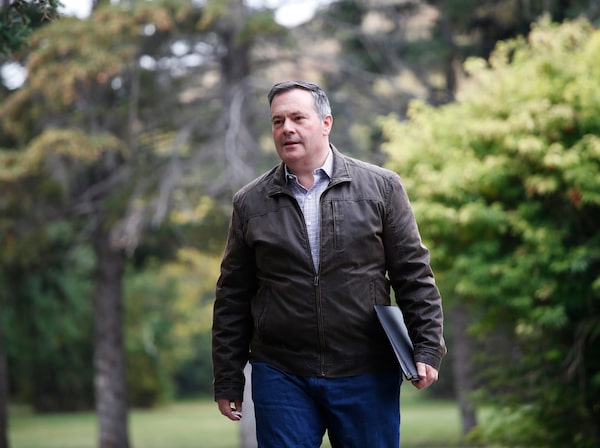
Alberta Premier Jason Kenney is photographed in Calgary on Sept. 15, 2020.Todd Korol/The Canadian Press
Among the provinces struggling to cope with a deadly second wave of the COVID-19 virus, Alberta stands out.
In recent weeks, daily case numbers have soared as high as 572. And Wednesday marked the 10th day in a row that the province of 4.3 million people set a new record for active cases – 4,793. All of which made the sight of hundreds of health care workers staging walkouts this week all the more bewildering.
How does that happen amid a pandemic?
Alberta is one messed-up place at the moment. The much-hoped-for rebound in the oil industry seems as far away as ever. The recently announced merger of Cenovus and Husky Oil is expected to result in more than 2,000 layoffs. Provincial debt continues to mount at a precipitous pace. Meantime, the United Conservative Party (UCP) government of Jason Kenney continues to engage in a nasty partisan campaign against the Liberal government in Ottawa, which, in turn, helps fuel incessant talk of separatism.
Right now all eyes are on Mr. Kenney’s conflict with the province’s health care sector. Earlier this year, he informed doctors they were going to have to accept new billing practices in an effort to rein in costs. That ignited a feud that continues to rage. More recently, Health Minister Tyler Shandro announced a plan to lay off up to 11,000 Alberta Health Services staff, most of whom are low-paid health care aides, practical nurses and those working in housekeeping, laundry and food services.
Mr. Shandro said he expects the moves to save $600-million. Others have questioned his arithmetic, saying what the government is really doing is getting these workers off its books. They will be rehired by private-sector contractors, they argue, who will then in turn bill Alberta Health Services for their work. In other words, they say, it’s a shell game primarily aimed at reducing the power of public-sector unions.
There is little question Mr. Kenney has unions in his sights. Since coming to power in 2019, his government has introduced several bills that have done everything from place restrictions on where unionized workers can picket to allowing replacement workers during strikes. Almost immediately upon taking office, the UCP suspended scheduled wage-increase arbitrations.
Now, the government has the ever-expensive public-health care sector in its crosshairs.
With the provincial deficit expected to hit $20-billion in the current fiscal year, it’s clear the Kenney government has to do something to cut costs. Public-sector wages reflect a time when government coffers were awash in oil-royalty revenue, and not the much different, grimmer reality of today. There is little question that a broad swath of the public understands the huge task in front of Mr. Kenney.
What many have taken exception to is Mr. Kenney’s approach. And it’s clear the Premier has rejected any notion of civil diplomacy, of trying to reach his objectives through calm, rational reasoning, favouring instead a more belligerent, combative posture. He may ultimately reach his goal, but it’s sure going to be ugly getting there.
Already, the province’s unions have warned that the walkouts are just the beginning. They are gearing up for a battle that they say Mr. Kenney started. They have launched a provincewide campaign, urging Albertans to “stand up” to the Premier and his government (even though, of course, not everyone believes the Premier is wrong).
Unquestionably, he could have chosen a better time to instigate a showdown with health care workers. But that seems to be a moot point now.
Some see this confrontation as a critical juncture in Mr. Kenney’s tenure. A recent editorial in the ultra-conservative Western Standard magazine, which reflects the thinking of a significant portion of the UCP base, said the Premier had “hit his defining moment in office.” The piece references the broad spending cuts that former Alberta premier Ralph Klein made in 1994, over the objections of unions – but which ultimately made him more popular than ever.
However, that history lesson neglected to mention that laundry workers at a Calgary hospital walked out to protest staff reductions and efforts to privatize their services. Soon, the strikes spread to several other hospitals and nursing homes. When it appeared the work stoppages were set to broaden even further, Mr. Klein backed off the scheduled cuts.
Faced with what is arguably a far worse fiscal situation than his conservative predecessor, Mr. Kenney will undoubtedly face a moment of truth himself.
Will he forge on, eyes wide open? Or will he also be inclined to blink?
Keep your Opinions sharp and informed. Get the Opinion newsletter. Sign up today.
 Gary Mason
Gary Mason